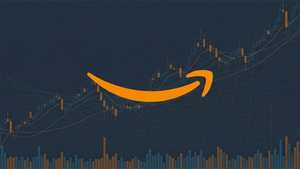
The financial technology (Fintech) sector is currently experiencing a period of robust growth and market enthusiasm, solidifying its position as a transformative force in the global economy. This surge is underscored by significant revenue expansion, increasing profitability, and a relentless drive for innovation across the industry. Leading this impressive charge is Robinhood Markets (NASDAQ: HOOD), the popular commission-free trading platform, whose stock has seen a dramatic leap, propelled by stellar second-quarter earnings and its recent inclusion in the S&P 500 index. This confluence of factors has not only cemented Robinhood's status as a market darling but also signals a broader maturation and validation of the Fintech landscape, capturing the attention of investors and industry observers alike.
The sector's overall health is evident in its impressive financial metrics, with total revenues for the industry jumping by 21% in 2024, a notable acceleration from 13% in the prior year. Public fintech firms are demonstrating strong fundamentals, with average EBITDA margins climbing from 12% to 16% in the same period, and nearly 70% of these companies now reporting profitability. This robust performance, further fueled by widespread AI adoption improving customer experience and efficiency, paints a picture of an industry poised for sustained expansion, with projections indicating the global fintech market could reach $1.13 trillion by 2032.
Robinhood's Meteoric Rise: Earnings Power and Index Validation
Robinhood Markets (NASDAQ: HOOD) has been at the epicenter of the Fintech sector's recent ascendancy, showcasing a remarkable trajectory that has seen its shares soar to unprecedented heights. On September 29, 2025, the company's stock reached an all-time high of $132.67, marking an astonishing year-to-date increase of over 226%, significantly outpacing the broader S&P 500. This meteoric rise has inflated Robinhood's market capitalization to over $100 billion and positioned it as one of the top-performing stocks of 2025.
The catalyst for much of this surge can be attributed to Robinhood's exceptionally strong Second Quarter 2025 earnings report, released on July 30, 2025. The company reported total net revenues of $989 million, a substantial 45% increase year-over-year, handily surpassing analyst expectations. Profitability also saw a dramatic improvement, with net income more than doubling, surging 105% year-over-year to $386 million. Diluted earnings per share (EPS) reached $0.42, a 100% increase from the previous year and well above forecasts. This robust growth was primarily driven by a 65% year-over-year rise in transaction-based revenues, with cryptocurrency revenue jumping 98% to $160 million and options revenue increasing 46% to $265 million. Furthermore, Robinhood Gold subscribers expanded by 76% year-over-year to 3.5 million, and total platform assets nearly doubled to $279 billion, signaling strong user engagement and asset accumulation.
Adding a significant layer of institutional credibility and market visibility, Robinhood achieved a major milestone with its official inclusion in the prestigious S&P 500 index, effective September 22, 2025. This move, which saw Robinhood replace Caesars Entertainment (NASDAQ: CZR), is a powerful endorsement from the broader financial market. The announcement itself triggered an immediate stock surge, as index-tracking funds and exchange-traded funds (ETFs) were mandated to purchase Robinhood shares to rebalance their portfolios. This passive buying pressure, combined with heightened investor confidence, has further amplified demand for Robinhood's stock and solidified its position within the mainstream financial services landscape. The timeline of these events – a strong earnings report in late July followed by S&P 500 inclusion in late September – created a powerful positive feedback loop, propelling Robinhood to its current market standing.
Ripple Effects Across the Financial Landscape: Winners and Losers Emerge
Robinhood's (NASDAQ: HOOD) ascent to the S&P 500 and the broader Fintech sector's robust performance are sending significant ripple effects across the financial landscape, creating both substantial opportunities for some companies and considerable challenges for others. This dynamic environment is driven by institutional validation, intensified competition, evolving revenue models, and heightened regulatory scrutiny.
Among the clear beneficiaries are Fintech partners and market makers. Companies that provide essential services such as payment processing, data analytics, or specialized financial tools are likely to find increased opportunities for collaboration with rapidly expanding platforms like Robinhood. Market makers, including prominent firms like Citadel Securities, IMC, Susquehanna, Wolverine, Jane Street, and Virtu Financial (NASDAQ: VIRT), stand to benefit significantly from the payment for order flow (PFOF) model that is central to Robinhood's revenue generation. Given Robinhood's substantial market share in both stock and options PFOF, these partners can expect continued revenue streams. Furthermore, Robinhood's S&P 500 inclusion sets a precedent that could pave the way for other retail-focused Fintechs to gain similar institutional acceptance. This validation can amplify their market capitalization, broaden their investor base, and improve access to financing. Companies venturing into emerging Fintech verticals, such as prediction markets, Layer 2 blockchain technology, tokenized assets, and crypto staking, may also find encouragement and increased investment as leaders like Robinhood expand into these innovative areas.
Conversely, traditional brokerages face significant pressure to adapt and innovate. Established players like Charles Schwab (NYSE: SCHW), Fidelity, and Interactive Brokers (NASDAQ: IBKR) must accelerate their digital transformation, expand into offerings like cryptocurrency trading, and enhance their user interfaces to compete with the agile and user-centric approach of Robinhood. While some, like Schwab, boast larger average assets under custody, Robinhood has surpassed many in sheer account numbers, highlighting the shifting competitive landscape. The success of diversified revenue models also poses a challenge to Fintechs overly reliant on Net Interest Income (NII), particularly in a potential falling interest rate environment. Companies with less diversified revenue streams will be more vulnerable to market fluctuations if they cannot adapt their income models.
Ultimately, companies unable to diversify or innovate will struggle to compete in this rapidly evolving sector. The dynamic nature of Fintech demands continuous technological advancement and adaptation to changing customer preferences. Moreover, as Fintech gains mainstream acceptance, regulatory scrutiny is expected to intensify. Companies with weak regulatory compliance or controversial business models could face significant challenges, including fines, legal battles, and reputational damage, as regulators focus on consumer protection and market stability. Robinhood's success, therefore, serves as both a beacon of opportunity and a stark reminder of the imperative for innovation and adaptability across the financial services industry.
Wider Significance: Fintech's Mainstream Ascent and Evolving Financial Landscape
Robinhood's (NASDAQ: HOOD) inclusion in the S&P 500 index on September 22, 2025, transcends a mere symbolic achievement; it signifies a pivotal moment for the financial technology (Fintech) sector, marking its definitive transition from a disruptive niche to an integral component of mainstream finance. This institutional validation reflects a profound shift in investor sentiment, cementing confidence in the financial resilience and strategic adaptability of digital-first platforms. The immediate 6-7% boost to Robinhood's stock price, driven by mandatory purchases from index-tracking funds, underscores the tangible benefits of such inclusion, enhancing market credibility, increasing liquidity, and generally lowering a company's cost of capital. It effectively redefines Robinhood's narrative from a "meme-stock darling" to a bona fide financial services player meeting stringent S&P criteria, including sustained profitability and substantial market capitalization.
This event is deeply embedded within broader industry trends that are reshaping finance. The Fintech sector is characterized by a drive towards diversification and the "super app" model, with companies like Robinhood expanding beyond initial offerings into areas such as options trading, cryptocurrency transactions, wealth management, and credit cards. There's also an intensified focus on profitability and efficiency, with greater scrutiny on capital-efficient growth and improved EBITDA margins across the sector. The integration of artificial intelligence (AI), particularly generative AI, is a critical priority, leveraged for enhanced fraud detection, automated underwriting, intelligent customer service, and capital markets intelligence. Furthermore, asset tokenization is gaining traction within crypto and blockchain, offering new investment avenues, while the overarching theme of democratization of finance continues to lower barriers for retail investors through features like fractional shares and zero-commission trading.
The ripple effects of Robinhood's success and the broader Fintech surge are substantial. It intensifies pressure on traditional brokerages to accelerate their digital transformation and offerings to remain competitive. For Fintech partners, Robinhood's growth opens new avenues for collaboration in areas like payment processing and data analytics. While positive for Robinhood, its high valuation may also prompt increased scrutiny for other high-growth Fintechs, compelling them to justify valuations through fundamental strength over time. This era may also usher in further Fintech consolidation and collaboration, as established financial institutions look to acquire or partner with technology-native challengers.
From a regulatory perspective, increased visibility and mainstream acceptance will undoubtedly bring heightened scrutiny for Robinhood and the entire Fintech sector. Regulators, such as the SEC, are likely to intensify their focus on consumer protection, market stability, and the oversight of emerging asset classes, particularly cryptocurrencies and tokenized assets. This could lead to new compliance requirements, potentially more coordinated international regulatory frameworks, and an ongoing tension between fostering innovation and ensuring robust regulatory compliance. Historically, the S&P 500 has consistently evolved to reflect the changing landscape of American industry, from industrial giants to tech leaders and e-commerce pioneers. Robinhood's inclusion, alongside other Fintechs like Block (NYSE: SQ) and Coinbase (NASDAQ: COIN), represents the latest iteration of this evolution, acknowledging Fintech as a core component of the financial ecosystem. While some draw comparisons to past retail trading booms like the Dot-Com Bubble, Robinhood's current inclusion is predicated on meeting rigorous S&P criteria, indicating a degree of fundamental strength that differentiates it from purely speculative ventures of the past.
What Comes Next: Navigating the Future of Fintech and Robinhood's Trajectory
Robinhood's (NASDAQ: HOOD) S&P 500 inclusion and robust performance mark a pivotal moment, not only for the company itself but also for the broader Fintech sector. This elevated status brings a landscape of both immense opportunities and formidable challenges, demanding strategic adaptation and foresight from all players involved.
In the short-term (late 2025 - 2026), Robinhood is expected to maintain its momentum, albeit with potential for volatility given its high beta and current elevated valuation. The company anticipates continued strong growth in its cryptocurrency business, bolstered by new staking options and expanded altcoin offerings, building on crypto's significant contribution to its Q2 2025 earnings. The nascent prediction markets segment, particularly through its partnership with Kalshi, is also poised to boost user engagement and contribute to market capitalization. Key product rollouts, such as "Robinhood Social" for copy trading, "Robinhood Banking" (expected Fall 2025), and the AI-powered "Cortex AI" stock screener, aim to enhance user experience and attract new demographics. The immediate benefits of S&P 500 inclusion, including increased liquidity and institutional investor confidence, will continue to play a role in its market stability. For the broader Fintech sector, expect continued growth, with AI and Machine Learning becoming deeply embedded in financial services, enhancing customer service, risk assessment, fraud detection, and personalization. Embedded finance will also gain further momentum, and regulatory bodies will continue to adapt frameworks, while cybersecurity remains a paramount concern.
Looking long-term (beyond 2026), Robinhood's vision is to evolve into a comprehensive "financial super-app," diversifying its offerings beyond traditional stock trading to include tokenization of financial assets, advanced AI-powered tools, and a full suite of banking services. A critical focus will be on further revenue diversification, shifting towards more stable, compounding income streams like net interest revenue and subscription services (Robinhood Gold). International expansion, through strategic acquisitions like Bitstamp for crypto licenses and European reach, will be crucial for accelerating user growth and geographical diversification. The Fintech sector as a whole is projected for significant market expansion, potentially tripling by 2032, driven by growth in WealthTech, open banking initiatives, and the increasing adoption of blockchain and digital assets, including the tokenization of financial instruments.
However, both Robinhood and the Fintech sector must navigate several critical strategic pivots and challenges. Robinhood must meticulously balance innovation with compliance, especially when venturing into new regulatory territories like tokenized securities and prediction markets. Reducing its reliance on payment for order flow (PFOF), which has faced regulatory scrutiny, will be essential for sustainable monetization in a low-margin environment. Enhancing user engagement and retention in a highly competitive landscape, and addressing concerns about potential overvaluation, will also be paramount. For the broader sector, intense competition from both established financial institutions and agile startups remains a constant challenge. Regulatory scrutiny on digital assets, data privacy, and market integrity will only intensify, requiring continuous adaptation and robust compliance. Market volatility and macroeconomic factors will continue to influence trading volumes and revenue, while cybersecurity threats demand ongoing investment in advanced solutions.
Potential scenarios for Robinhood include a bull case where it successfully executes its "financial super-app" strategy, achieving robust growth across diversified revenue streams and becoming a dominant global financial infrastructure provider. A bear case could see it struggle to diversify, remaining overly reliant on volatile transaction-based revenue, facing significant regulatory headwinds, and succumbing to competitive pressures, leading to a stock decline. A mixed or adaptive case might see Robinhood achieving niche dominance in specific high-growth areas like crypto or AI-driven tools, potentially through strategic partnerships, rather than becoming an all-encompassing financial hub. The coming months and years will reveal which path Robinhood and the Fintech sector ultimately take, shaped by innovation, regulatory evolution, and market dynamics.
Comprehensive Wrap-up: Fintech's Enduring Transformation and Future Outlook
Robinhood's (NASDAQ: HOOD) landmark inclusion in the S&P 500 index on September 22, 2025, represents far more than a corporate milestone; it signifies a profound transformation for the entire Fintech sector. This event, driven by Robinhood's robust financial performance—including a 45% year-on-year increase in total net revenue to $989 million and a near-doubling of net income to $386 million in Q2 2025—validates the enduring power and profitability of digital-first financial platforms. The immediate stock surge, a classic "inclusion effect," underscores the heightened investor confidence and liquidity that now underpin Robinhood's market position. This strategic diversification into options, crypto investing, and margin lending has solidified its standing as a scalable financial ecosystem, following a trend set by other leading Fintechs like Coinbase (NASDAQ: COIN) earlier in the year.
Beyond Robinhood, the Fintech sector has demonstrated remarkable strength, evolving from a disruptive force to a cornerstone of the global financial ecosystem. Recent data indicates Fintech revenues surged by 21% year-over-year in 2024, significantly outpacing traditional banking. Profitability has also improved, with approximately 69% of public Fintech companies generating profits, signaling a shift towards sustainable, scalable performance. This growth is largely fueled by the pervasive integration of Artificial Intelligence (AI) for automating compliance, enhancing customer interactions, and improving fraud detection, alongside the expansion of embedded finance and robust digital infrastructure. The sector is also witnessing a strategic pivot towards B2B(2X) services, financial infrastructure, and lending, while consumer-focused markets show signs of maturation.
Moving forward, Robinhood's S&P 500 inclusion is expected to enhance its market credibility, attract a broader and more stable institutional investor base, and improve its stock's liquidity, potentially reducing its historical volatility. For the broader Fintech sector, this development signifies increased institutional acceptance and validation, cementing its status as an integral part of the core financial infrastructure. This trend is likely to accelerate consolidation within the Fintech space, as traditional financial institutions recognize the imperative to compete with and integrate technology-native challengers. The S&P 500's evolving composition increasingly reflects the rising influence of Fintech, indicating a systemic shift in how financial services companies are perceived and valued.
Ultimately, Robinhood's journey from a "meme stock" to an S&P 500 constituent is a watershed moment for the Fintech industry. It marks a clear transition from "disruption" to "institutional integration," establishing Fintech as a permanent pillar of the American market. This redefines the boundaries of what is achievable for retail-focused platforms, proving that they can achieve profitability, diversification, and scale within traditional financial structures. It powerfully underscores the ongoing convergence of technology and finance, where innovation is no longer merely disruptive but foundational to the market's evolution.
For investors, the coming months will require careful observation. For Robinhood, watch its ability to sustain innovation amidst evolving regulatory landscapes and competitive pressures. Key areas include the execution of its international expansion strategies, particularly in tokenized trading and 24/7 market access, and its ongoing integration of banking services, wealth management, and institutional-grade crypto offerings. Given Robinhood's premium valuation, analysts caution that there is little room for disappointment, especially considering its dependence on potentially volatile trading revenues and regulatory uncertainties surrounding crypto operations. Investors should pay close attention to consistent profitability, growth metrics, and margin stability. For the broader Fintech sector, look for companies that successfully navigate regulatory uncertainties, optimize embedded financial services, responsibly harness AI, and prioritize cybersecurity. Further consolidation through mergers and acquisitions is anticipated, particularly targeting firms offering innovative financial infrastructure. Companies that effectively integrate AI capabilities into their core operations, especially in algorithmic trading, risk assessment, and regulatory compliance, are poised to emerge as primary beneficiaries of future investment.
This content is intended for informational purposes only and is not financial advice

















